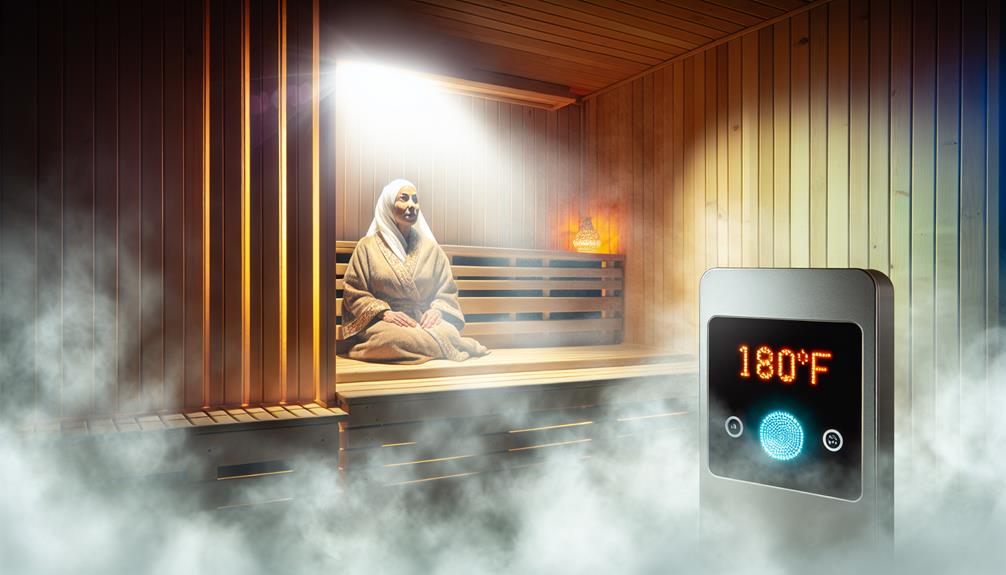When considering what temperature a sauna should be, it's crucial to take into account the specific type of sauna you are using. Traditional saunas typically operate within a range of 150-175°F, offering a classic and intense heat experience.
On the other hand, infrared saunas tend to be set at a lower temperature between 120-130°F, providing a more gentle and consistent warmth. However, the question remains, how does the temperature of a sauna impact your body and overall well-being?
Let's explore the significance of sauna temperature variations and their effects on health and relaxation.
Key Takeaways
- Traditional saunas operate best at 150-175°F for intense heat experience and deep sweating.
- Steam saunas at 110-120°F offer gentle, humid environment for skin hydration and respiratory health.
- Ideal dry heat saunas maintain 150-175°F for relaxation, detoxification, and improved blood circulation.
- Infrared saunas range from 120-140°F, promoting longer sessions for enhanced detox and toxin elimination.
Optimal Traditional Sauna Temperature
When aiming for an optimal traditional sauna experience, maintaining a temperature range between 150-175°F (65-80°C) is key to ensure both comfort and effectiveness during your session. Traditional saunas typically operate at temperatures around 174°F (79°C) to induce sweating and relaxation effectively. However, some individuals may find higher temperatures, ranging from 185-195°F (85-90°C), suitable for shorter sessions if well-tolerated. On the other hand, lower temperatures around 140-150°F (60-65°C) cater to those who prefer a milder sauna experience.
Adjusting the sauna temperature within this recommended range can accommodate personal preferences and enhance comfort levels during your session. It's crucial to find a balance that allows you to reap the benefits of the sauna while ensuring that the heat remains tolerable and enjoyable for you. Whether you opt for a more intense sweat-inducing session or a gentler heat experience, the traditional sauna's flexibility in temperature settings can cater to a wide range of individual preferences.
Steam Sauna Temperature Guidelines
To optimize your steam sauna experience, understanding the recommended temperature guidelines is essential for achieving a comfortable and effective session. Steam saunas typically operate at temperatures ranging from 110-120°F (43-49°C), providing a gentle and humid environment that is beneficial for respiratory health and skin hydration. These lower temperatures compared to traditional saunas reduce the risk of overheating or discomfort, making the steam sauna experience more relaxing.
Here is a table summarizing the key points about steam sauna temperature guidelines:
| Aspect | Information |
|---|---|
| Temperature Range | 110-120°F (43-49°C) |
| Therapeutic Benefits | Gentle and humid environment, ideal for respiratory health and skin hydration |
| Controlled Temperature | Maintains consistent temperature to promote sweating and detoxification without excessive heat stress |
| Sauna Session | Enhances therapeutic benefits while ensuring a safe and enjoyable sauna experience |
| Skin Hydration | Lower temperatures in steam saunas help maintain skin hydration |
Ideal Dry Heat Sauna Temperature

For an optimal dry heat sauna experience, maintaining a temperature range of 150-175°F is crucial to promote relaxation and detoxification effectively. Here are some key points to consider:
- Therapeutic Benefits: The heat within this temperature range helps in opening up your pores, aiding in the release of toxins from your body, and promoting overall relaxation.
- Circulation: The warmth from the sauna at 150-175°F can improve blood circulation, which is beneficial for cardiovascular health and muscle recovery.
- Sweating: The higher temperatures in this range can induce a good sweat, which can assist in purging impurities and cleansing the skin.
- Comfort and Monitoring: While some may find higher temperatures invigorating, it's essential to prioritize your comfort. Regularly monitor the sauna temperature and adjust it to suit your preferences, ensuring a pleasant and safe experience.
Infrared Sauna Temperature Recommendations
Transitioning from the ideal dry heat sauna temperature discussion, the recommended temperature range for optimal benefits in infrared saunas typically falls between 120-140°F.
Unlike traditional saunas, the lower temperature in infrared saunas allows for longer sessions lasting between 20-45 minutes, enhancing the detoxification process. It's essential to maintain a consistent temperature within this range to ensure a comfortable and effective sauna session.
The moderate heat generated by infrared saunas at 120-140°F effectively penetrates the body, promoting sweating and aiding in the elimination of toxins. Following manufacturer guidelines regarding temperature settings is crucial in maximizing the health benefits associated with using an infrared sauna.
Sauna Temperature Impact on Health

Maintaining the appropriate sauna temperature is crucial for optimizing the health benefits and ensuring safe and effective sauna sessions. Here's how sauna temperature impacts your health:
- Traditional Saunas: Operating between 150-195°F, traditional saunas promote deep sweating, aiding in detoxification and relaxation.
- Infrared Saunas: With temperatures ranging from 104-140°F, infrared saunas penetrate the body more directly, offering therapeutic effects like improved circulation and pain relief.
- Stress Reduction: The optimal sauna temperature induces a state of relaxation, reducing stress hormones and promoting a sense of calmness.
- Pain Management and Blood Circulation: Proper sauna temperature can help alleviate muscle tension, joint pain, and enhance blood flow, which is beneficial for recovery and overall well-being.
Frequently Asked Questions
What Is a Healthy Temperature for a Sauna?
For a sauna, maintaining an ideal temperature between 150-175°F is crucial. This range ensures optimal heat therapy, health benefits, and safety during your sweat session. Consistent monitoring of temperature in your wellness routine maximizes therapeutic effects and heat tolerance while promoting sauna safety.
Is 200 Degree Sauna Too Hot?
Feeling like a boiling kettle, a 200-degree sauna can overwhelm your body's heat tolerance. Protect yourself by starting lower, watching sweat levels, hydrating well, and cooling down when needed. Prioritize sauna safety.
How Long Should I Sit in a Sauna?
To maximize sauna benefits, prioritize safety by limiting sessions to 10-15 minutes. Remember sauna etiquette for relaxation and therapy. Hydrate well, take breaks for cooling down, and maintain a weekly frequency of 3-4 sessions for optimal results.
What Is the Best Temperature for a Sauna Detox?
In a sauna detox, the ideal heat promotes sweating, aiding in the detox process. Sweating effects include body purification and skin rejuvenation. Heat therapy in saunas offers health benefits when you regulate the temperature to your comfort.
Conclusion
In conclusion, finding the right temperature for your sauna experience is crucial for maximizing its benefits. Whether you prefer the intense heat of a traditional sauna or the gentle warmth of an infrared sauna, experimenting with different temperatures can help you find the perfect balance for your body.
Remember to listen to your body's cues and stay hydrated to ensure a safe and enjoyable sauna session. Your health and wellness are worth the effort.

Leave a Reply